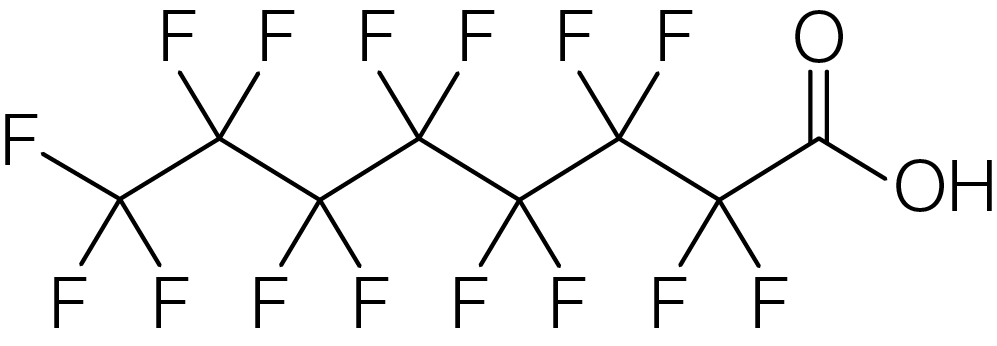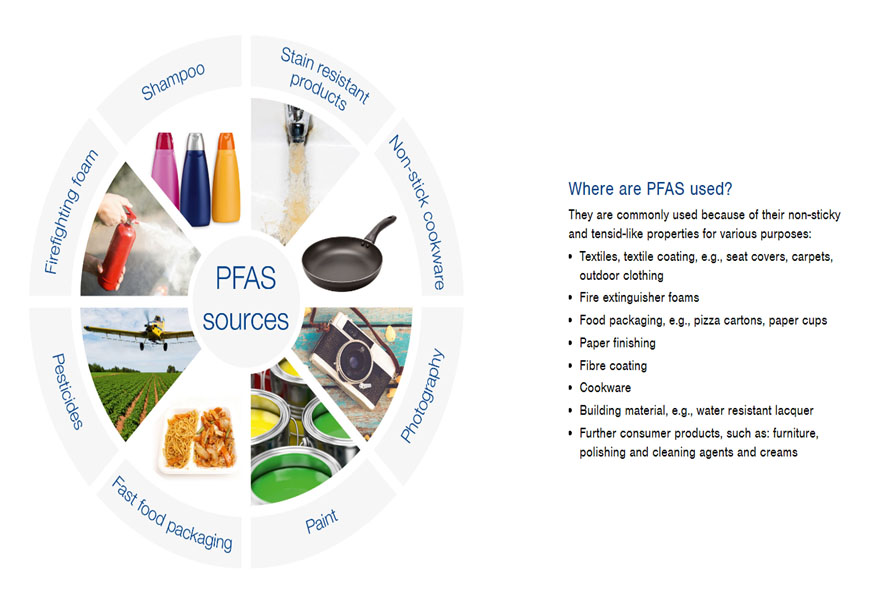
Per- and polyfluoroalkyl substances (PFAS) are organic compounds with a carbon chain in which hydrogen atoms are substituted by fluorine. The carbon-fluorine bond is one of the strongest in chemistry making them “virtually indestructible “. Hence the name “forever chemicals”.
The molecular structure of PFAS provides them with non-sticky and tensid-like characteristics (due to their hydrophobic, lipophilic chain + hydrophilic head).
There are polymers and non-polymers. Typical polymers are fluoropolymers, sidechain fluorinated polymers and perfluoropolyethers. Typical non-polymers are perfluoroalkyl acids (PFFFAs), perfluroalkane sulfonyl fluorides (PASF), perfluroalkyl iodides (PFAIs) and per- and polyfluoroalkyl ether (PFPEs) based derivatives.
Perfluorooctanoic acid (PFOA) and perfluorooctanesulfonic acid (PFOS) have been the most produced and studied of these chemicals.
 |  |
| Structure PFOA | Structure PFOS |
PFAS have been manufactured for more than 80 years, but health effects were neglected until recently. In September 2020, the European Food Safety Authority (EFSA) published a new health risk assessment related to the presence of PFAS in food (3). This is the first EFSA expert opinion in which, in addition to PFOA and PFOS, other PFAS were also included in the exposure and health risk assessments.
PFAS are emitted into the environment by different pathways. For example, exhaust air from industrial sources can contain PFAS and thus are dispersed into nearby ground and water bodies. Rain and snow, for example, can eventually carry them from the air into the soil and surface waters. Particle accumulation can even cause them to travel long distances through the air. Thus, PFAS are also found far from industrial production sites and human living areas, such as in sediments from the Bering Sea to the Arctic. Through volatilization from products (evaporation from carpets or home textiles treated with soil-repellent agents), or from waterproofing sprays, indoor air can also be contaminated.
Soil can be directly contaminated, for example by firefighting foams. With the uptake of PFAS from contaminated soils and waters in vegetation and their accumulation in fish, these substances enter the human food chain. Consequently, humans absorb PFASs from the environment through food, water or air.
These "forever chemicals" also find their way into wastewater treatment facilities from household sources. They then enter surface waters via treated wastewater or remain in sewage sludge. The sewage sludge, in turn, is used as fertilizer in agriculture, and over time these chemicals eventually leach into the groundwater. Once there, some of the precursor compounds transform into the persistent PFAS.

Solutions for PFAS Analysis
The EPA has released two standards (EPA 533 and EPA 537.1) for measuring PFAS in drinking water using solid phase extraction (SPE) columns together with LC/MS instruments. The FDA also released method C-010.02 for PFAS Determination in Processed Foods using LC/MS.
As toxicological information and additional PFAS compounds are identified in the future, further directives, restrictions, and regulations will be issued over time.
This pollution will therefore affect us all for generations. Chromatographic analysis will help us quantify the impact and make monitoring possible.
MACHEREY-NAGEL has developed a number of products for these methods.